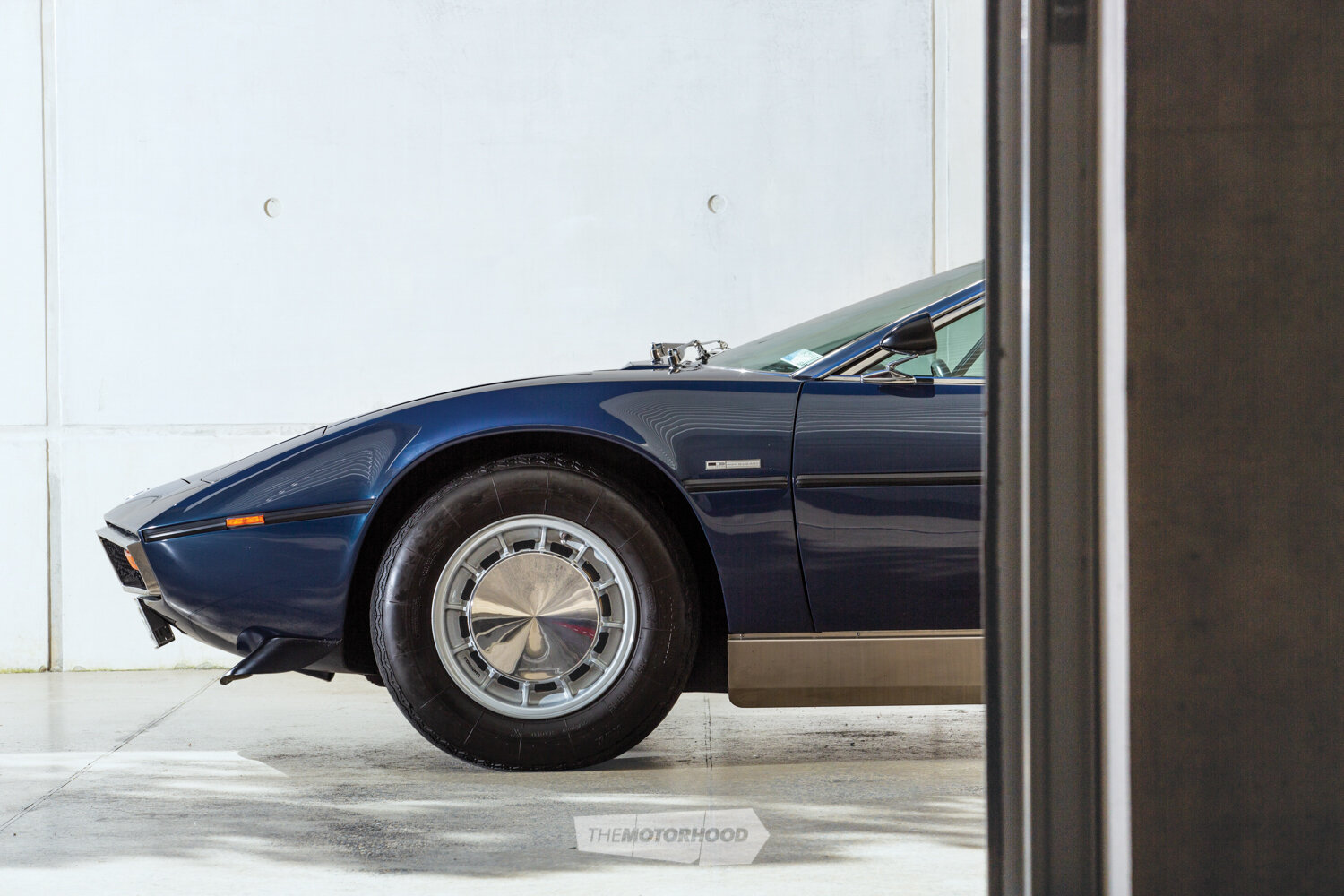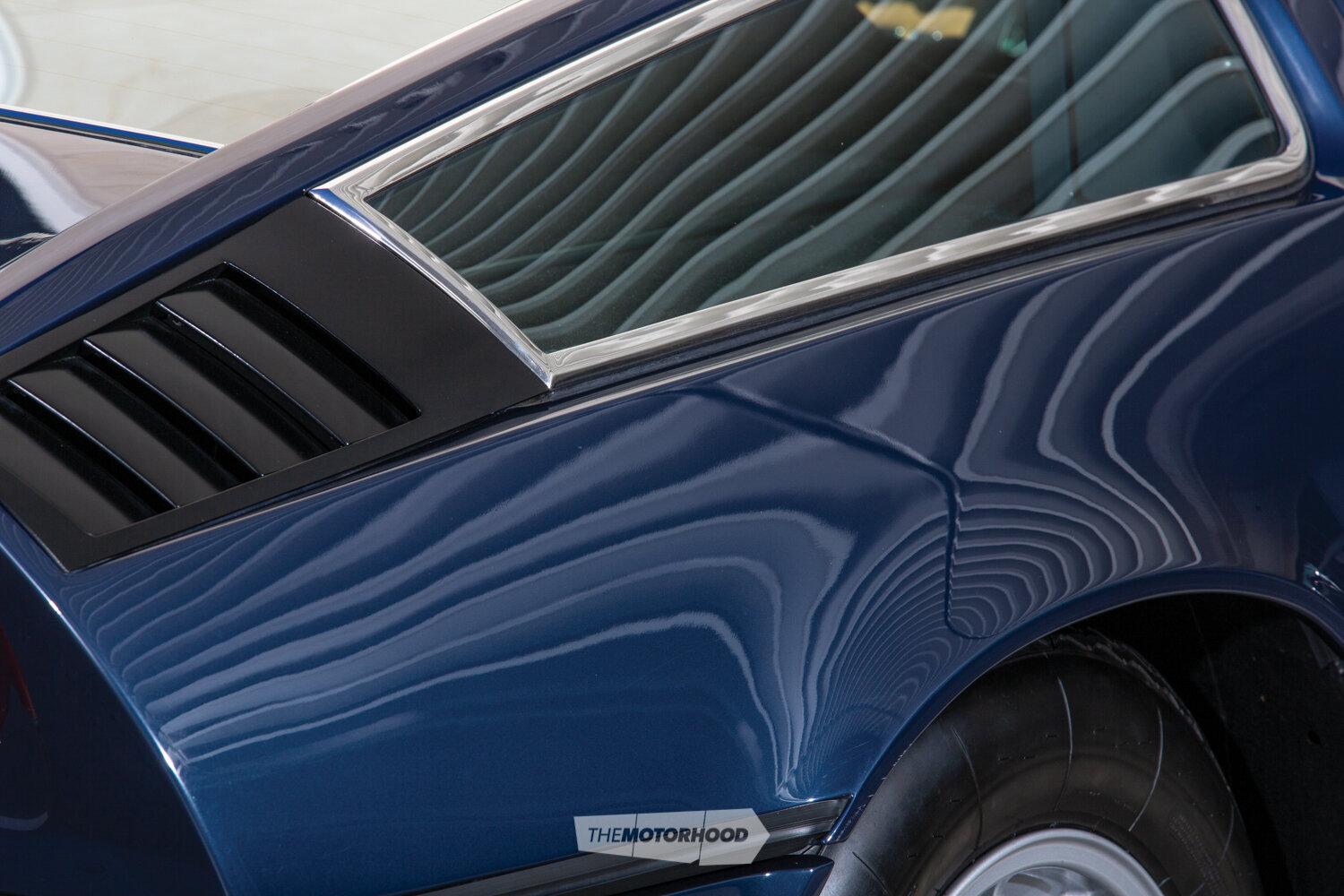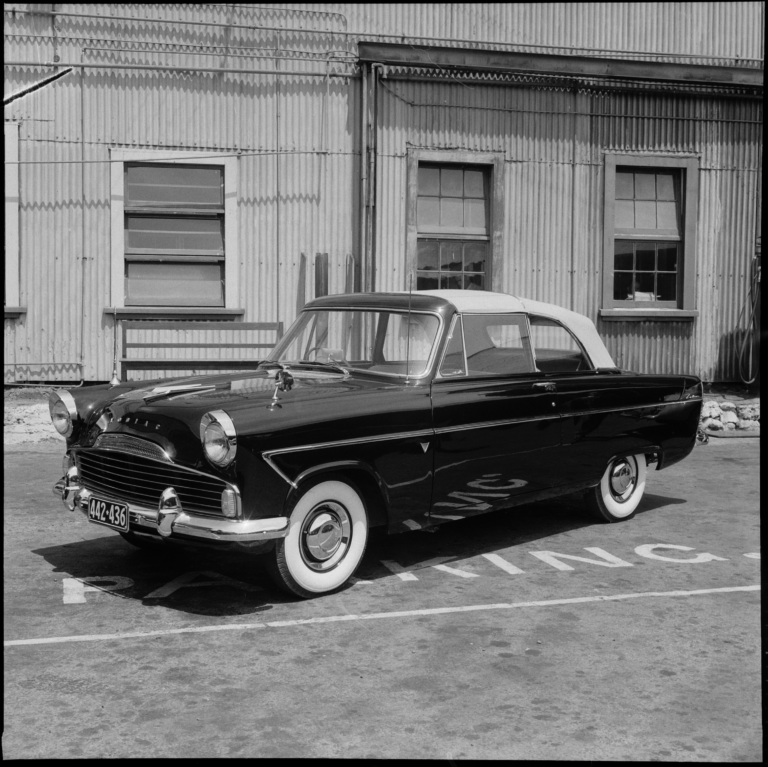Maserati named a number of its cars after winds because, in its opinion, that’s what the cars go like — the wind!

The dramatic mid-engine Bora, named after the katabatic wind of the same name — a sometimes hurricane-force wind that blows off the Adriatic Sea — was the star of the show when it was officially unveiled to an enthusiastic crowd at the Geneva Motor Show in March 1971. The Bora, Maserati’s first and only mid-engine V8 supercar, known internally as the Tipo 117, was a response to the gorgeous Lamborghini Miura. It first saw daylight in the summer of 1969, as the Italian car manufacturer started testing the first prototype of the car.
Maserati commissioned Italdesign, Giorgetto Giugiaro’s burgeoning design company, to develop this new genre of Maserati, resulting in a body design that was indeed striking, with svelte angular lines showcasing its unique engine bay. It was totally covered in a glass canopy, emphasized by a low roofline covered in brushed stainless steel.
Giulio Alfieri, the co-designer of the legendary 250F Formula One car, was given the task of developing all technical aspects of the Bora, and construction of the bodywork was entrusted to Officine Padane SpA of Modena.
The Ferrari Daytona introduced in 1968 sported a conventional front-engine V12 layout, so Maserati’s decision to make the Ghibli’s replacement mid-engined demonstrated its intense eagerness to establish the company’s technical expertise in design and engineering.
During the design phase of the Bora, Maserati demanded that the new supercar be stylish, solidly built, fast and reliable and, above all, refined and comfortable.


Technically advanced
Underneath the handsome Italdesign body design, the Bora was technically advanced for the time. Alfieri turned to Maserati’s fabulous 4.7-litre quad-cam alloy V8 engine descended from the 450S race car to ensure the sleek mid-engined cruiser performed as well as it looked good. Mounted longitudinally ahead of the rear axle, the 90-degree V8 engine boasted four Weber 42 DCNF downdraught carburettors and electronic Bosch ignition, and was mated to a ZF five-speed transaxle featuring an independent suspension system designed by Alfieri, comprising coil springs, anti-roll bars, and telescopic shocks. It made the Bora the first production Maserati to adopt a fully independent rear suspension system. To reduce noise and vibration, the entire suspension assembly was mounted on a tubular subframe, which was anchored to the all-steel monocoque chassis by four flexible mountings.
Large hydraulically operated ventilated disc brakes were fitted all round, 240mm diameter up front and 248mm at the rear. Benefiting from Maserati’s Citroën association, a unique, highly pressurised hydraulic braking system was adopted to provide the necessary stopping power. With almost zero pedal movement, stopping power requires virtually no effort — a feature that a few drivers took some getting used to. Power-assisted rack-and-pinion steering was also fitted, offering an effective and responsive driving experience.
The distinctive French-tech driving experience didn’t stop the Bora from becoming a must-have set of wheels for the rich and famous, including the likes of Karim Aga Khan and Sophia Loren’s husband, the movie producer Carlo Ponti.
In 1973, Maserati built a Bora specifically for the American market, complete with an emissions-friendly 4.9-litre V8. In order to comply with other US safety regulations, larger bumpers were added to the front and rear of the car, degrading its clean sleek appearance. In 1975, the 4.9-litre engine became standard on all Boras. During the Bora’s production run 289 examples were created with the 4.7-litre engine and 235 with the 4.9-litre V8.

French connection
The Bora was one of the first new models to be released after Citroën gained a controlling interest in Maserati in 1968 — hence its unique hydraulic braking system. Beneath the attractive satin-finished, stainless-steel roof panel, the hydraulic system was also used to operate the retractable headlights that were concealed in the bonnet to retain the Bora’s sleek look, and a hydraulically adjustable pedal box, which moved fore and aft in lieu of moving the seat. No fore and aft adjustment is provided for the driver’s seat so the driver remains pretty much the same distance from the dash and windscreen regardless of the seat and pedal settings. The hydraulic system also lifts the one-piece height-adjustable driver’s seat, which is also manually adjustable for angle. Further comfort for the driver is offered thanks to a telescoping steering column, adjustable for rake and reach, complete with a thick, leather-rimmed, 14-inch steering wheel, making the Bora significantly easier to climb in and out of than its rivals from Sant’Agata and Maranello.
Liveable supercar
In keeping with Maserati’s brief to create a refined and comfortable supercar, the interior was elegantly appointed. The bucket seats, facia, door trim, and rear bulkhead were trimmed in rich quality leather, as was the centre console, which housed the electric window switches, air-conditioning controls, air vent, and radio. The dashboard received the same leather treatment, and featured an array of well-positioned Veglia analogue instrumentation, such as speedometer, rev counter, oil pressure, oil temperature, water temperature, fuel level gauge, battery condition indicator, and clock.


Despite Maserati’s ultimate goal of producing a performance supercar, usability and refinement were also built into the Bora — a departure from the typical Italian exotica of the period. Underneath the raked bonnet the boot area was more than adequate for this type of car, and taller drivers definitely benefited from the adjustable pedal cluster and steering column. The rear bulkhead between the engine and the cockpit received plenty of sound deadening insulation, and even the rear window between the interior and the engine bay was double-glazed. Access to the rear and engine was through a large opening hatch that incorporated nicely shaped side windows and the large almost horizontal heated rear window. Unlike other mid-engined sports cars of the period, an easily removable, carpeted, dome-shaped, aluminium cover was fitted over the engine for additional sound insulation. When removed, it revealed the huge air cleaner on top of the four twin-choke Weber carburettors and gave plenty of access to other engine essentials. The spare wheel sat behind the engine and above the transmission in a vinyl cover for easy access.
The Bora was undoubtedly a capable mid-engine supercar and considerably more practical than its competition. In typical Maserati fashion, it was a quality supercar with style, reliability, and comfort — not to mention stunning looks. This is a car made for driving, and in that respect it is designed to satisfy the most demanding enthusiast.
Steadfast passion
Readers of this publication will no doubt be familiar with the name Paul Halford. Several cars from Paul’s enviable collection have graced these pages over the years and if there’s one thing we’ve come to know about Paul, its his steadfast passion for exotic Italian sports cars including Lancia, Ferrari, Lamborghini, Alfa Romeo, and Maserati.

Paul first spotted our featured Maserati Bora back in 2003 while it was undergoing a full nut-and-bolt restoration by Myles Hicks and his late father Gavin.
“We spotted the car on the internet,” Myles said, “and thought it would be a good project — and, being a Maserati, Gavin couldn’t turn it down.”
The car was imported into New Zealand from Petersburg, Virginia, and sat at the back of the Hicks’ workshop for several years while Gavin and Myles slowly gathered parts and attended to other restoration projects.
“The car was in reasonable shape with very little rust and as we already had another accident-damaged Bora, we had access to many hard-to-get parts,” Myles explained.
The entire restoration was completed in-house, including the painting, upholstery, and rebuilding of mechanical items. The Hicks also changed the unsightly American bumpers for European-style units that were skilfully handcrafted by Gavin.
Great addition
Paul was well aware of the rarity of this fine Italian thoroughbred and thought it would make a great addition to his collection. After some discussion, it was decided that Gavin and Myles would complete the restoration first, as they were unable to confirm a completion date. Paul asked if the car could be painted in the original red but Gavin and Myles didn’t like that idea. After searching through some old Maserati colour charts, they decided that Blue Sera would be best suited to showing off the Bora’s striking lines and it would contrast nicely with the brushed aluminium roof panel.
Paul recalled: “One fabulous day, I received a call out of the blue from Gavin to say the Maserati had been shown for the first time at the 2007 Ellerslie Classic Car Show and [they were] ready to release it to me.”
At the final inspection, Paul said, he realized that “the car was better than when it left the factory” — a testament to the passion of the Hickses and the expertise of their flawless workmanship. Once the final paperwork and the exchanging of funds were completed, Paul took delivery of another fine exotic Italian ’70s supercar.





